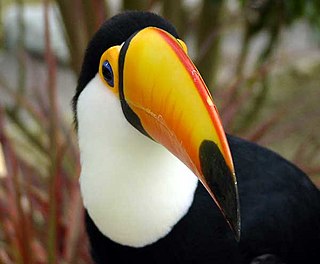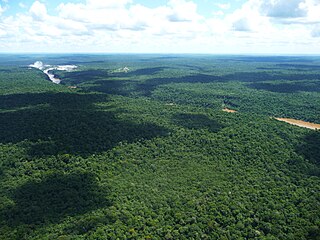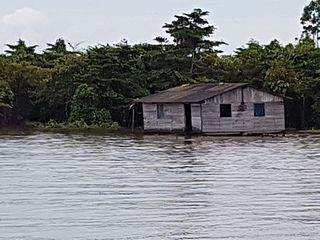
The Atlantic Forest is a South American forest that extends along the Atlantic coast of Brazil from Rio Grande do Norte state in the northeast to Rio Grande do Sul state in the south and inland as far as Paraguay and the Misiones Province of Argentina, where the region is known as Selva Misionera.

Justicia is a genus of flowering plants in the family Acanthaceae. It is the largest genus within the family, encompassing around 700 species with hundreds more as yet unresolved. They are native to tropical to warm temperate regions of the Americas, India and Africa. The genus serves as host to many butterfly species, such as Anartia fatima. Common names include water-willow and shrimp plant, the latter from the inflorescences, which resemble a shrimp in some species. The generic name honours Scottish horticulturist James Justice (1698–1763). They are closely related to Pachystachys.

The Atlantic Coast restingas is an ecoregion of the tropical and subtropical moist broadleaf forests biome, and the South American Atlantic Forest biome. It is located along Brazil's Atlantic coast, from the country's northeast to its southeast.

The Serra do Mar coastal forests is an ecoregion of the tropical moist forests biome, and of the South American Atlantic Forest biome.

Justicia aurea, the Brazilian plume or yellow jacobinia, is an ornamental shrub native to the Cerrado vegetation of Brazil. This plant may be propagated by herbaceous stem cutting, and it can usually get to 1,50 - 2,50 m tall. They flourish in the shade, and will not do well if overwatered.
Justicia clausseniana is a flowering perennial plant in the family Acanthaceae. It is native to the Atlantic Forest ecoregions of eastern Brazil.

The wildlife of Brazil comprises all naturally occurring animals, plants, and fungi in the South American country. Home to 60% of the Amazon Rainforest, which accounts for approximately one-tenth of all species in the world, Brazil is considered to have the greatest biodiversity of any country on the planet. It has the most known species of plants (55,000), freshwater fish (3,000), and mammals. It also ranks third on the list of countries with the most bird species (1,832) and second with the most reptile species (744). The number of fungal species is unknown but is large. Approximately two-thirds of all species worldwide are found in tropical areas, often coinciding with developing countries such as Brazil. Brazil is second only to Indonesia as the country with the most endemic species.

The Alto Paraná Atlantic forests, also known as the Paraná-Paraíba interior forests, is an ecoregion of the tropical moist forests biome, and the South American Atlantic Forest biome. It is located in southern Brazil, northeastern Argentina, and eastern Paraguay.

Restingas are a distinct type of coastal tropical and subtropical moist broadleaf forest in eastern Brazil. They form on sandy, acidic, and nutrient-poor soils, and are characterized by medium-sized trees and shrubs adapted to the drier and nutrient-poor conditions. One of the most notable restingas is the Restinga da Marambaia, which is owned and kept by the Brazilian Army.

The Caatinga enclaves moist forests is an ecoregion of the Tropical moist forests Biome, and the South American Atlantic Forest biome. It is located in northeastern Brazil.

The Pernambuco coastal forests is an ecoregion of the Tropical moist broadleaf forests Biome, and the South American Atlantic Forest biome. It is located in northeastern Brazil.

The "Pernambuco" interior forests is an ecoregion of the Tropical and subtropical moist broadleaf forests Biome, and the South American Atlantic Forest biome. It lies in eastern Brazil between the coastal Pernambuco coastal forests and the dry Caatinga shrublands of Brazil's interior.

Caatinga is a type of subtropical vegetation, and an ecoregion characterized by this vegetation in interior northeastern Brazil. The name "Caatinga" is a Tupi word meaning "white forest" or "white vegetation".

Caladenia carnea, commonly known as pink fingers, is a plant in the orchid family Orchidaceae and is endemic to eastern and south-eastern Australia, including Tasmania. It has a single thin, green leaf and one to five white or pink flowers with red stripes and two rows of yellow-tipped "calli" on their labellum.

Ipomoea carnea, the pink morning glory, is a species of morning glory. This flowering plant has heart-shaped leaves that are a rich green and 6–9 inches (15–23 cm) long. It can be easily grown from seeds which are toxic and it can be hazardous to cattle; the toxicity is related to the swainsonine produced by endophytes and to bioaccumulation of selenium species in leaves but mostly in seeds

Dorstenia elata is a plant species in the family Moraceae.

Quesnelia seideliana is a species of bromeliad in the genus Quesnelia.

The Gurupa várzea (NT0126) is an ecoregion of seasonally and tidally flooded várzea forest along the Amazon River in the Amazon biome.

The Uatuma–Trombetas moist forests (NT0173) is an ecoregion in northwest Brazil in the Amazon biome. It covers the Amazon basin north of the Amazon River from close to the Atlantic Ocean to the Rio Negro west of Manaus. The ecoregion is relatively intact, although it has been damaged along the main rivers and around population centers.

The Guianan moist forests (NT0125) is an ecoregion in the east of Venezuela, north of Brazil and the Guyanas. It is in the Amazon biome. The climate is hot and humid, with two rainy seasons each year. As of 1996 the tropical rainforest habitat was relatively intact, although there were mounting threats from illegal logging and gold mining.



















